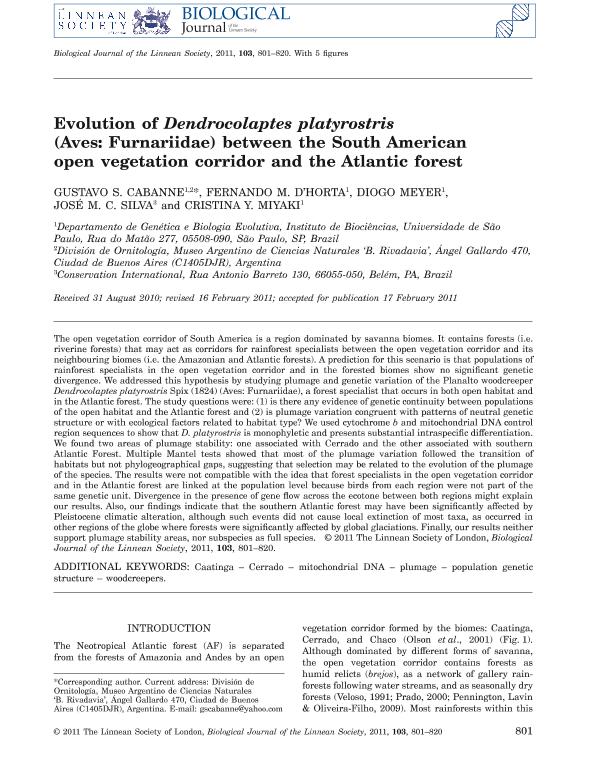Artículo
Evolution of Dendrocolaptes platyrostris (Aves: Furnariidae) between the South American open vegetation corridor and the Atlantic forest
Cabanne, Gustavo Sebastián ; D'Horta, Fernando M.; Meyer, Diogo; Silva, José M. C.; Miyaki, Cristina Yumi
; D'Horta, Fernando M.; Meyer, Diogo; Silva, José M. C.; Miyaki, Cristina Yumi
 ; D'Horta, Fernando M.; Meyer, Diogo; Silva, José M. C.; Miyaki, Cristina Yumi
; D'Horta, Fernando M.; Meyer, Diogo; Silva, José M. C.; Miyaki, Cristina Yumi
Fecha de publicación:
08/2011
Editorial:
Wiley Blackwell Publishing, Inc
Revista:
Biological Journal of The Linnean Society
ISSN:
0024-4066
Idioma:
Inglés
Tipo de recurso:
Artículo publicado
Clasificación temática:
Resumen
The open vegetation corridor of South America is a region dominated by savanna biomes. It contains forests (i.e. riverine forests) that may act as corridors for rainforest specialists between the open vegetation corridor and its neighbouring biomes (i.e. the Amazonian and Atlantic forests). A prediction for this scenario is that populations of rainforest specialists in the open vegetation corridor and in the forested biomes show no significant genetic divergence. We addressed this hypothesis by studying plumage and genetic variation of the Planalto woodcreeper Dendrocolaptes platyrostris Spix (1824) (Aves: Furnariidae), a forest specialist that occurs in both open habitat and in the Atlantic forest. The study questions were: (1) is there any evidence of genetic continuity between populations of the open habitat and the Atlantic forest and (2) is plumage variation congruent with patterns of neutral genetic structure or with ecological factors related to habitat type? We used cytochrome b and mitochondrial DNA control region sequences to show that D. platyrostris is monophyletic and presents substantial intraspecific differentiation. We found two areas of plumage stability: one associated with Cerrado and the other associated with southern Atlantic Forest. Multiple Mantel tests showed that most of the plumage variation followed the transition of habitats but not phylogeographical gaps, suggesting that selection may be related to the evolution of the plumage of the species. The results were not compatible with the idea that forest specialists in the open vegetation corridor and in the Atlantic forest are linked at the population level because birds from each region were not part of the same genetic unit. Divergence in the presence of gene flow across the ecotone between both regions might explain our results. Also, our findings indicate that the southern Atlantic forest may have been significantly affected by Pleistocene climatic alteration, although such events did not cause local extinction of most taxa, as occurred in other regions of the globe where forests were significantly affected by global glaciations. Finally, our results neither support plumage stability areas, nor subspecies as full species. © 2011 The Linnean Society of London.
Archivos asociados
Licencia
Identificadores
Colecciones
Articulos(MACNBR)
Articulos de MUSEO ARG.DE CS.NAT "BERNARDINO RIVADAVIA"
Articulos de MUSEO ARG.DE CS.NAT "BERNARDINO RIVADAVIA"
Citación
Cabanne, Gustavo Sebastián; D'Horta, Fernando M.; Meyer, Diogo; Silva, José M. C.; Miyaki, Cristina Yumi; Evolution of Dendrocolaptes platyrostris (Aves: Furnariidae) between the South American open vegetation corridor and the Atlantic forest; Wiley Blackwell Publishing, Inc; Biological Journal of The Linnean Society; 103; 4; 8-2011; 801-820
Compartir
Altmétricas



